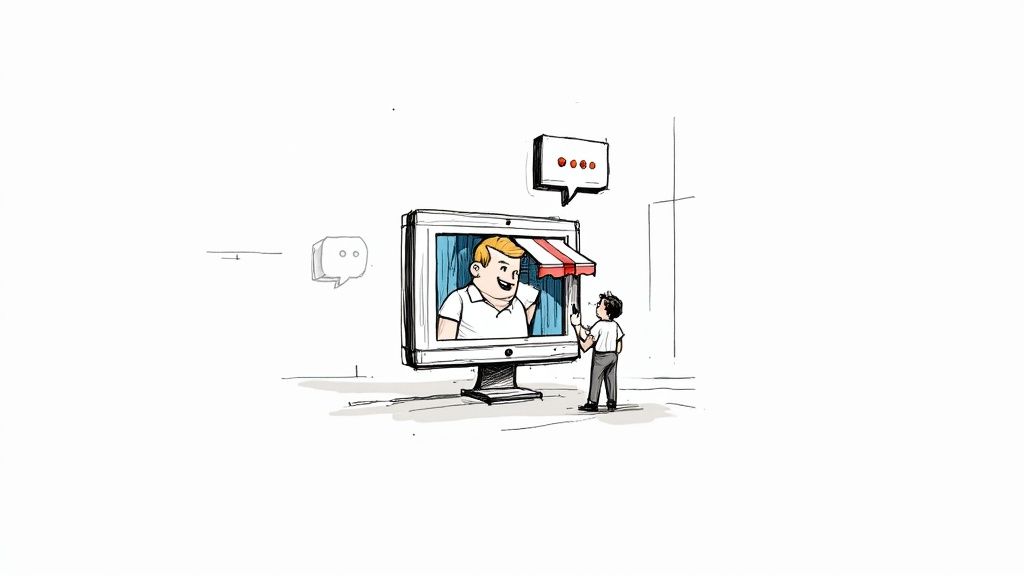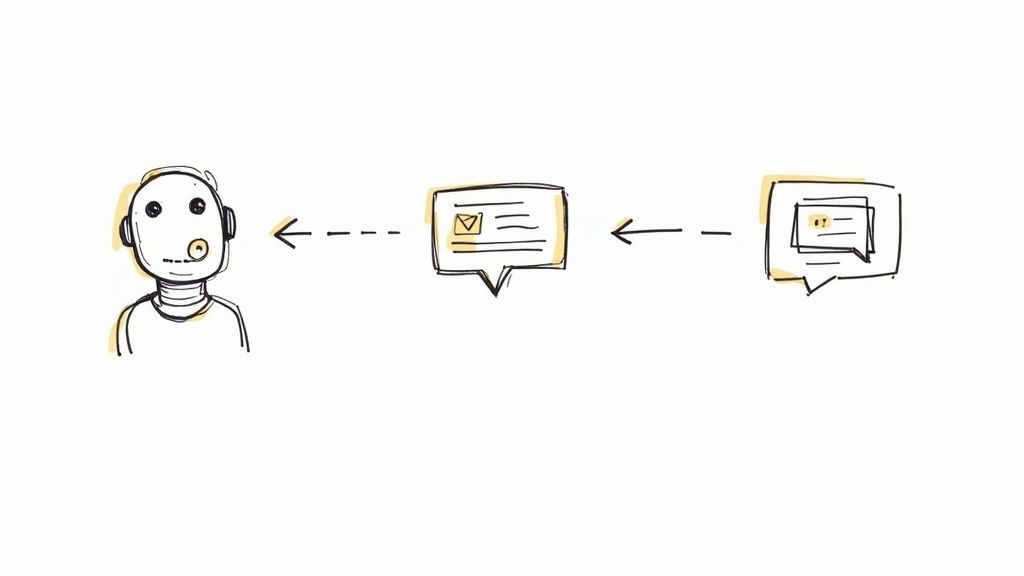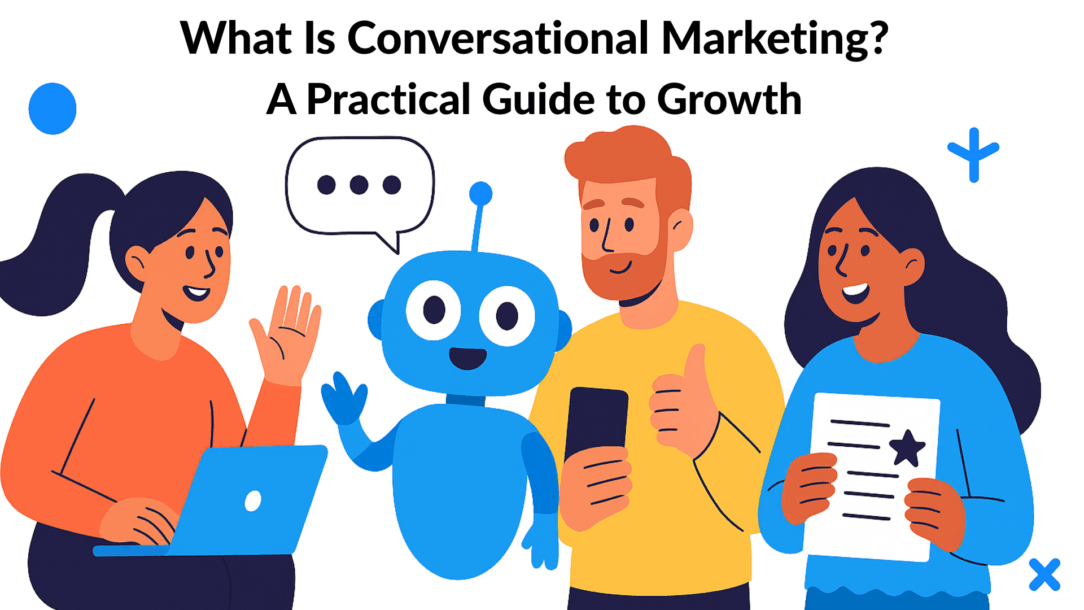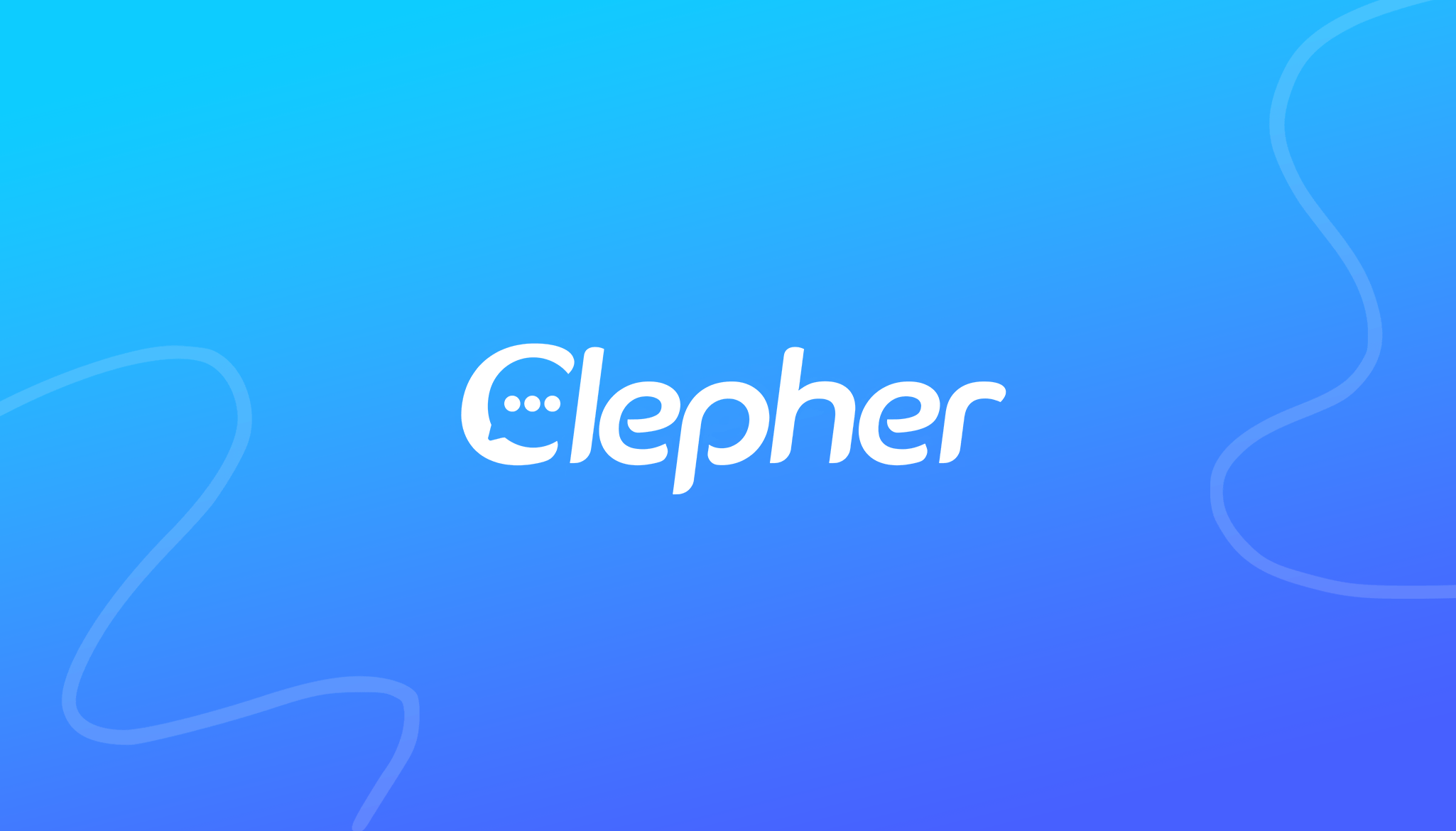Think of conversational marketing as the digital version of a friendly shop assistant who greets you the moment you walk into a store. It’s a total shift from the old method of shouting one-way messages at an audience. Instead, it’s about starting real-time, one-on-one conversations that solve customer problems on the spot. The entire focus is on building relationships through immediate, personal interactions.
What Is Conversational Marketing in Practice?

conversational marketing
Let’s get practical. A potential customer lands on your website at 10 PM. In the old marketing playbook, they’d fill out a form and wait. Maybe for days. By the time you reply, their interest has faded, or worse, a competitor has already solved their problem.
Conversational marketing flips that script. It meets customers where they are, the second they show interest. Instead of a static “Contact Us” form, they’re greeted by a friendly chatbot or live chat window. This immediately opens a dialogue, turning a passive browse into an active, helpful conversation.
The core idea is brilliantly simple: talk to people the way they talk to friends and family—through messaging. This approach removes friction, making it incredibly easy for people to get answers, find what they need, and feel confident enough to make a purchase.
The Shift From Monologue to Dialogue
Traditional marketing often feels like a monologue. Businesses broadcast messages through ads, emails, and social media posts, hoping something resonates. Conversational marketing, a term that gained traction around 2010, transforms this into a genuine two-way dialogue.
It leverages channels like chatbots, live chat, and social media messaging to create instant, personalized communication. You can explore a detailed overview from IBM on how this changes the marketing landscape.
To see the transformation clearly, let’s compare the old way with the new.
| Feature | Traditional Marketing | Conversational Marketing |
|---|---|---|
| Communication Style | Monologue (one-way broadcast) | Dialogue (two-way conversation) |
| Response Time | Slow (hours or days) | Instant (real-time, 24/7) |
| Interaction | Passive (forms, static pages) | Active (live chat, chatbots) |
| Personalization | Generic (mass messaging) | Personalized (tailored to user behavior) |
| Goal | Lead capture (often high-friction) | Relationship building and immediate help |
| Customer Feeling | Like a number in a database | Valued and understood |
This table highlights the fundamental difference. One approach makes customers wait; the other serves them instantly and personally.
This transformative approach is built on three key principles:
- Engage: It starts conversations in real-time, 24/7, ensuring no lead or question ever falls through the cracks.
- Understand: It actively listens to customer needs and gathers data to provide tailored responses and ideal solutions.
- Recommend: It guides customers to the right answer, whether that’s a specific product, a helpful article, or a connection to a human agent.
The goal isn’t just to talk; it’s to listen, understand, and help. Conversational marketing treats every interaction as an opportunity to build trust and deliver value, not just push for a sale.
So, what is conversational marketing, really? It’s the art of using targeted, real-time messaging to guide buyers smoothly through your marketing and sales funnels. By making your business more approachable and instantly responsive, you shorten the sales cycle, boost customer satisfaction, and build stronger, more loyal relationships.
The Technology Driving Modern Conversations

technology in modern conversations
To make real-time, one-on-one conversations happen at scale, you need a powerful engine running behind the scenes. This engine is a mix of smart tools built to engage customers the second they reach out, day or night. The core components are live chat, AI chatbots, and the messaging apps everyone already uses.
Think of it like a perfectly run restaurant. Live chat is the host who can handle special requests and add a personal touch. Chatbots are automated systems that take reservations and answer common questions 24/7. Together, they ensure every guest gets immediate attention, creating a smooth and satisfying experience.
This blend of human intelligence and automated efficiency is what makes modern conversational marketing so powerful.
The Key Players in Conversational Tech
At the heart of any solid strategy are the tools that make these dialogues possible. Today’s conversational marketing relies on advanced technologies, like AI Chat for marketing, which fall into a few key categories.
Let’s break down the essential tech:
- Live Chat: This is your direct line, connecting a website visitor with a real human in real-time. It’s perfect for solving complex problems, building genuine rapport, or closing a sale where a personal touch makes all the difference.
- Chatbots: Think of these as your automated digital crew. They can handle a massive number of inquiries at once, qualify leads by asking the right questions, and provide instant answers to common questions. Their 24/7 availability means you never miss an opportunity to connect.
- Messaging Apps: Platforms like Facebook Messenger, Instagram DMs, and WhatsApp are where your customers are already active. By meeting them there, you can send order updates, run promotions, and offer support in a familiar, trusted environment.
The real magic is making these tools work together. A great system can start a conversation with a chatbot and seamlessly hand it off to a live agent if the conversation gets too complex for the bot to handle.
Rule-Based vs. AI-Powered Chatbots
Not all chatbots are created equal. Understanding the difference between a simple rule-based bot and a smarter AI bot is crucial for choosing the right tech for your goals. It separates a clunky, frustrating experience from a smooth, helpful one.
A rule-based chatbot follows a strict script, like a digital flowchart. It only understands specific commands and keywords it’s been programmed to recognize. These bots are excellent for straightforward tasks, like booking an appointment or answering a simple FAQ.
An AI-powered chatbot, however, uses technologies like machine learning to understand the intent behind someone’s words, not just the keywords. You can dive deeper into how these bots interpret language by exploring Natural Language Processing in chatbots. This allows them to handle far more complex questions, learn from interactions, and hold more natural, human-like conversations over time.
Why Conversational Marketing Is a Growth Engine

conversational marketing as growth engine
Conversational marketing isn’t just a friendlier way to chat with customers—it’s a serious engine for business growth.
Think about the old way: slow, one-way communication creates business headaches like lagging lead follow-ups, high support costs, and sales opportunities that vanish. Conversational marketing transforms this by offering instant dialogues that directly improve your bottom line.
Instead of making potential buyers wait for an email, you engage them the second their interest peaks. That immediacy cuts the friction that kills deals, turning passive website visitors into qualified leads before they consider a competitor. It’s about transforming your marketing from a passive net into an active conversation, guiding customers to solutions and shrinking the time it takes to go from “just looking” to “just bought.”
Shrink Your Sales Cycle
The traditional sales cycle is painfully slow. A lead fills out a form. They wait. A sales rep eventually sees it. The lead waits again for a call or email. Every delay is a chance to lose interest or find someone else.
Conversational marketing blows past this waiting game.
By using a chatbot to ask qualifying questions and book a demo on the spot, you can compress a multi-day process into minutes. Exploring an interactive product demo guide can show how this approach cuts down sales cycles and boosts conversions.
This instant engagement achieves several key goals at once:
- Instant Qualification: Bots pre-qualify leads 24/7, so your sales team spends their time only with high-intent prospects.
- Immediate Scheduling: Forget the back-and-forth emails. Leads can book meetings directly in the chat window without leaving your site.
- Reduced Friction: By answering questions immediately, you remove the doubts and roadblocks that slow down a buying decision.
You’re meeting buyers on their terms and on their schedule. When you do that, you collapse the time it takes to make a sale. The faster you deliver value, the faster you close the deal.
Boost Lead Conversion and Build Loyalty
Slashing friction doesn’t just speed things up; it has a massive impact on conversion rates. When a customer gets an instant answer to a question about pricing or features, they are far more likely to take the next step.
The results speak for themselves. Some businesses report a 45% increase in conversion rates, and others have seen lead generation jump by a staggering 67% after implementing chatbots.
But this isn’t just about new leads. The same principle applies to customer loyalty.
Imagine an existing customer has an issue at 9 PM on a Sunday and gets instant support. They feel heard, valued, and understood. That level of service builds incredible trust, turning one-time buyers into brand advocates for years to come. Ultimately, conversational marketing delivers a powerful return on investment by making your business more efficient, helpful, and human at every stage of the customer journey.
Conversational Marketing Strategies in Action
Theory is one thing, but seeing how real companies put these ideas to work is where the magic happens. Conversational marketing isn’t a high-tech toy reserved for giant corporations; businesses of all sizes use it to solve frustrating, everyday problems—from lost sales to buried support teams.
The best strategies zero in on a specific point of friction in the customer journey and apply a simple conversational fix. Let’s look at a couple of practical examples. Each one follows a blueprint you can steal: spot the problem, deploy a conversation, and watch the results.
The E-commerce Sizing Assistant
An online clothing store noticed a painful pattern: a high rate of abandoned carts on their best-selling jeans product pages. Analytics showed customers would add the perfect pair to their cart, hesitate, and then leave.
The Business Challenge: Customers were afraid of choosing the wrong size. The fear of a bad fit and the hassle of returns was killing sales at the finish line.
The Conversational Solution: The store added a proactive chatbot to its denim product pages. If someone lingered for more than 15 seconds, a message popped up: “Having trouble finding the perfect fit? I can help you find your size in under a minute!”
The bot asked two simple questions: the customer’s height and the fit of their favorite jeans from another brand. Using that information, it instantly recommended the right size. If the situation was tricky, it offered a one-click button to chat with a live style expert.
The Impressive Results:
- Cart abandonment on those pages dropped by 27% in the first month.
- Returns due to incorrect sizing went down by 15%.
- Customer satisfaction scores for shoppers who used the bot were 40% higher.
This wasn’t just about answering a question; it was about giving the customer instant confidence. By removing doubt at a critical moment, the store turned hesitation into a sale.
The B2B Lead-Qualifying Machine
A B2B SaaS company was driving great traffic to its website with content marketing, but their sales team was drowning in unqualified leads from their contact forms. They spent hours sifting through submissions from students, job seekers, and businesses that were not a good fit.
The Business Challenge: The sales team’s time was being wasted on junk leads, slowing down their response to genuinely interested prospects and crushing morale.
The Conversational Solution: They replaced their static “Request a Demo” form with an intelligent chatbot. Now, when a visitor clicks the button, the bot starts a conversation to qualify them in real time, 24/7.
It asks a few key questions:
- What is your company size?
- What is your role?
- What problem are you trying to solve?
If the lead fits their ideal customer profile, the bot automatically shows the sales rep’s calendar to book a demo on the spot. If not, it politely points them toward other resources, like a webinar. You can find more ideas in our guide to the best chatbot examples.
The Impressive Results:
- The sales team cut time spent on lead qualification by a massive 60%.
- The number of qualified demos booked each month jumped by 35%.
- The average sales cycle shortened by six days because reps engaged with high-intent leads almost immediately.
Implementing Your First Conversational Strategy
Diving into conversational marketing can feel overwhelming, but the trick is to start small. Don’t try to automate your entire customer journey on day one. Instead, pick one high-impact problem and solve it. This focused approach delivers a tangible win, fast, building momentum and proving the concept before you invest more.
Your first move? Pinpoint a single, specific goal. Where is the biggest friction point for your customers right now? Maybe it’s your pricing page, where confusion leads to exits. Or perhaps your lead capture form is so clunky that good prospects give up.
Once you’ve found that weak spot, set a clear, measurable objective. A solid starting goal is: “Capture 20% more qualified leads from our pricing page this month.” This target will shape every decision, from the questions your bot asks to the metrics you track.
Designing a Human-Like Conversation
The best conversational bots don’t feel like bots. They feel like a quick chat with a helpful expert. The key is to anticipate what your visitor wants and guide them to an answer with as little effort as possible. Keep it natural, friendly, and get straight to the point.
Here’s a simple checklist to design your first conversation:
- Map the Flow: Sketch out the conversation on a whiteboard. What’s the first question? What are the likely replies? Draw out each path to ensure the chat flows logically toward your goal.
- Keep It Brief: No one wants to read an essay in a chat window. Use short sentences and simple questions. Break down complex ideas into bite-sized messages.
- Set Clear Expectations: Let people know they’re talking to a bot. It builds trust. More importantly, always provide an easy way to talk to a person. A simple, “I’m a bot, but I can connect you to a human anytime!” works wonders.
- Use Personalization: If you have data, use it. Greeting a returning visitor by name or acknowledging the page they’re on makes the experience feel less robotic and more effective.
The economic value of this approach is substantial. For instance, Gamma generated over $1 million in closed revenue through conversational marketing, alongside a 33% increase in website conversions. These outcomes highlight how effective a well-planned strategy can be, as you can discover more in these conversational marketing statistics.
Plan for a Smooth Handoff
Finally, remember that bots and humans are a team. Automation is here to make your people better, not replace them. A critical part of your strategy is planning for a seamless handoff when a conversation needs a human touch.
Ensure your bot is smart enough to gather essential info—like the user’s name, email, and their question—before it transfers them to your live team. This way, your team can jump into the conversation with full context, without making the customer repeat themselves. It’s a small detail that creates a smooth, professional experience. Getting this right is a huge step, and a detailed guide on how to build a chatbot can walk you through structuring these crucial handoffs.
Got Questions About Conversational Marketing? We Have Answers
Even when a new strategy makes perfect sense, it’s natural to have questions. Moving away from old-school marketing is a big step, and it’s smart to clear up any doubts before you jump in.
Think of this as the final check-in before you hit “go.” We’ll tackle the most common questions marketers and business owners ask so you can move forward with total confidence.
Is Conversational Marketing Only for Large Companies?
Not at all. While giant corporations use it to manage massive inquiry volumes, conversational marketing is a game-changer for small and medium-sized businesses. Affordable tools and simple live chat platforms give SMBs the power to offer 24/7 customer service and capture leads without needing a huge team.
For a small business, a chatbot is like your hardest-working employee. It qualifies leads while you sleep, answers common questions instantly, and even books appointments, freeing you and your team to focus on work that requires a human touch.
The trick is to start small. Pick one specific, high-impact goal—like capturing leads from your pricing page—and build from there.
Conversational marketing levels the playing field. It gives smaller businesses the ability to deliver instant, personal service that used to be reserved for companies with giant call centers.
Will Chatbots Replace My Team?
Nope. The goal isn’t replacement, it’s empowerment. The best strategies create a powerful partnership between bots and humans—it’s not one or the other.
Chatbots are brilliant at handling repetitive tasks with speed and accuracy. Think of them as the first line of defense, perfect for:
- Answering the same handful of questions over and over, any time of day.
- Qualifying new leads by asking a few simple, structured questions.
- Directing customers to the right person or department without delay.
This frees up your human team to handle complex problems, build real relationships, and close big deals. The ideal setup is a smooth handoff where a bot gathers basic info and then seamlessly transfers the conversation (and its context) to a human expert at the right moment.
How Do I Measure the ROI?
You can’t improve what you don’t measure. The ROI of conversational marketing comes down to the goals you set from day one. Your key performance indicators (KPIs) will depend entirely on what you’re trying to achieve.
For example, if your main goal is lead generation, you’ll want to track:
- The total number of leads your chat captures.
- Your conversion rate from chat lead to qualified opportunity.
- The cost per qualified lead generated.
If you’re focused on driving sales, your metrics might look like this:
- The number of sales demos or meetings booked through your bot.
- The total revenue that was directly influenced by chat conversations.
And if it’s all about improving customer support, you should monitor:
- Your ticket deflection rate (how many issues the bot solves on its own).
- Customer Satisfaction (CSAT) scores after a chat.
- The drop in your average first response time.
Most modern conversational marketing platforms have built-in dashboards that make tracking these numbers simple, so you can easily prove the value it’s adding.
What’s the First Step to Get Started?
Getting started is easier than you think. The key is to avoid trying to do everything at once. A focused, step-by-step approach gets you results much faster.
First, find the biggest point of friction in your current customer journey. Where are people getting stuck or dropping off? Is it on your pricing page, where one unanswered question kills a sale? Or in your support queue, where long waits cause frustration?
Second, pick one specific problem to solve. Frame your first project with a narrow goal, like, “I want to answer questions and book more demos directly from my homepage.” This keeps it manageable.
Finally, choose a simple tool that fits that specific need and your budget. Start with a basic, rule-based chatbot for that one use case. Build a simple conversation, launch it, and see what happens. Don’t try to build a super-intelligent AI on day one. Start small, learn from real interactions, and build on what works.
Conclusion
In conclusion, understanding what conversational marketing is can significantly enhance your marketing efforts and optimize customer interactions. By leveraging conversational marketing tools, businesses can create a personalized experience that effectively addresses customer pain points and expectations throughout the buying process. This strategy that uses conversational AI, chatbots, and live chat fosters two-way communication, ensuring real-time customer engagement across multiple channels.
The benefits of conversational marketing are clear: improved customer experience, increased conversion rates, and enhanced engagement between marketing and sales teams. To truly harness the power of conversational marketing, it’s essential to guide the conversation with the right content, enabling you to connect with customers meaningfully.
If you’re ready to take your digital marketing to the next level and learn how conversational marketing can help you improve your marketing activities, get Clepher to assist you with your goals. This can help you strategize effectively, implement marketing automation, and utilize conversational marketing examples that resonate with your audience.
Don’t miss out on the opportunity to enhance your customer experience!
Related Posts



